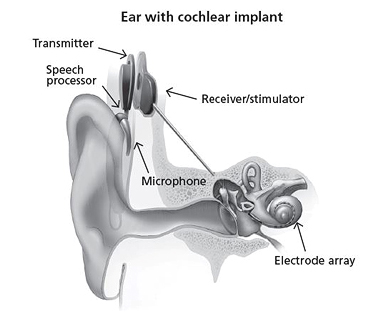Cochlear Iimplant

A cochlear implant is a small, complex electronic device that can help to provide a sense of sound to a person who is profoundly deaf or severely hard-of-hearing. The implant consists of an external portion that sits behind the ear and a second portion that is surgically placed under the skin (see figure). An implant has the following parts:
- A microphone, which picks up sound from the environment.
- A speech processor, which selects and arranges sounds picked up by the microphone.
- A transmitter and receiver/stimulator, which receive signals from the speech processor and convert them into electric impulses.
- An electrode array, which is a group of electrodes that collects the impulses from the stimulator and sends them to different regions of the auditory nerve.
A cochlear implant is very different from a hearing aid. Hearing aids amplify sounds so they may be detected by damaged ears. Cochlear implants bypass damaged portions of the ear and directly stimulate the auditory nerve. Signals generated by the implant are sent by way of the auditory nerve to the brain, which recognizes the signals as sound. It allows people to recognize signals, understand other sounds in the environment, and understand speech in person or over the telephone.
Children and adults who are deaf or severely hard-of-hearing can be fitted for cochlear implants.
For young children who are deaf or severely hard-of-hearing, using a cochlear implant while they are young exposes them to sounds during an optimal period to develop speech and language skills. Research has shown that when these children receive a cochlear implant followed by intensive therapy before they are 18 months old, they are better able to hear, comprehend sound and music, and speak than their peers who receive implants when they are older. Studies have also shown that eligible children who receive a cochlear implant before 18 months of age develop language skills at a rate comparable to children with normal hearing, and succeed in mainstream classrooms.
Some adults who have lost all or most of their hearing later in life can also benefit from cochlear implants. They learn to associate the signals from the implant with sounds they remember, including speech.
Use of a cochlear implant requires both a surgical procedure and significant therapy to learn or relearn the sense of hearingThe decision to receive an implant should involve discussions with medical specialists, including an experienced cochlear-implant surgeon.. Speech-language pathologists and audiologists are frequently involved in this learning process.
Before the procedure
You or your child will need a detailed medical evaluation to determine if cochlear implants are a good option. A doctor will conduct an evaluation that may include:
- Ordering tests of hearing, speech and sometimes balance
- Performing a physical examination to assess your inner ear's health
- Ordering MRI or CT imaging tests of the skull to assess the condition of the cochlea and inner ear structure
- Ordering mental health (psychological) testing in select cases to determine your ability to learn to use cochlear implants
During the procedure
Your surgeon will make a cut (incision) behind your ear, and form a small hole in the portion of skull bone (mastoid) where the internal device rests.
Your surgeon will then create a small opening in the cochlea in order to thread the electrode of the internal device. The skin incision is stitched closed so that the internal device is under your skin.
After the procedure
You or your child might experience:
- Pressure or discomfort over the implanted ear or ears
- Dizziness or nausea
Most people feel well enough to return home the day of surgery or the next day.
An audiologist won't turn on (activate) the cochlear implants for about two to six weeks after your surgery — to give the surgery site time to heal.
Activation
To activate the cochlear implant, an audiologist will:
- Adjust the sound processor to fit you or your child
- Check the components of the cochlear implant to make sure they work
- Determine what sounds you or your child hears
- Give you information on the proper care and use of the device
- Set the device so that you can hear to the best of your ability
Rehabilitation
Rehabilitation involves training your brain to understand sounds heard through the cochlear implant. Speech and everyday environmental noises will sound different from what you remember.
Your brain needs time to recognize what these sounds mean. This process is ongoing and is best achieved by wearing the speech processor continuously during waking hours.
Results of cochlear implant surgery vary from person to person. Factors that can affect the outcomes of cochlear implantation include the age when hearing was lost, and the length of time between hearing loss and the cochlear implant surgery.
For children, the best results generally occur with getting a cochlear implant at a young age.
For adults, the best results are generally associated with a shorter period of profound hearing loss before cochlear implantation
Some predicted outcomes may include:
- Clearer hearing.Many people who meet the hearing criteria for cochlear implantation eventually get clearer hearing with using the device.
- Improved tinnitus.Although ear noise (tinnitus) isn't a primary reason to receive a cochlear implant, the cochlear implant may partially suppress or improve the severity of tinnitus during use.
Reach out to us at Shruti ENT Hospital and cochlear implant centre for further details.
